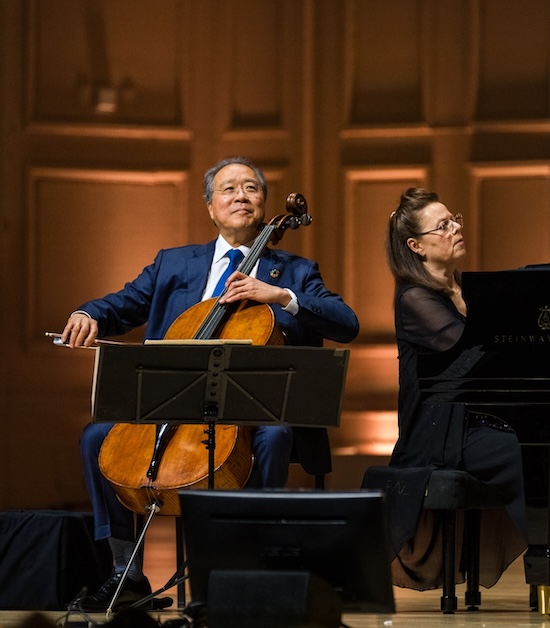Performances
Tetzlaff & Gerstein explore the radical side of Brahms and others for Celebrity Series
Arnold Schoenberg thought so highly of Johannes Brahms that he grafted […]
Retooled Quatuor Ébène in first-class form at Shriver Hall
The Quatuor Ébène was last heard locally in 2014 at the […]
Tapped as Chicago Symphony music director, Klaus Mäkelä makes an exhilarating stand with Shostakovich
Klaus Mäkelä was announced as the future music director of the […]
Concert review
Ma & Stott close long musical partnership in generous style in Boston

Yo-Yo Ma and pianist Kathryn Stott offered a fitting tribute to the myriad beauties of musical friendship to a full house at Boston’s Symphony Hall.
Tuesday evening’s performance was one of the last of the nearly 40-year collaborative relationship between Ma and Stott, as Ma told the audience. Earlier this year, Stott announced her retirement from public performance at the end of 2024 to devote her time to teaching and supporting young musicians.
More than anything—more than the compelling programming, the fine playing, and the warm atmosphere—the musical relationship between Ma and Stott was the highlight of the evening. Both are exceptionally generous players, and the pair made evident the ways in which their mutual musical exploration brought them together and maintained the partnership for four decades. (As Ma told the audience, Stott designs the programming for all their recitals and recording projects.)
The program opened with a suite of shorter works assembled by Stott—Fauré’s Berceuse, Dvořák’s “Songs My Mother Taught me,” Assad’s Menino, Boulanger’s Cantique, and Fauré’s Papillon—which set the musical aesthetic of the evening. These songs, sweet, wandering, earnest, and intimate by turns, also mirrored the ways Ma and Stott perform as a seamless team, each anticipating the other through long familiarity with the other’s playing and style.
Ma’s cello sang in Boulanger’s Cantique: his long, vigorously directed phrases, played with a sweetness of tone and earnestness of feeling, plus Stott’s sensitivity, made the Cantique the beating heart of this little suite. While his approach to the more technical sections was sometimes gestural/casual, Ma’s playing is more emotive than ever—soulful, powerful, and earnest, with his belief in the power of music evident both in his commentary and in his performance.
The choice of the Shostakovich Cello Sonata offered both contrast and continuity following the opening suite. Even as Shostakovich’s biting irony seemed a break with the gentle preceding melodies, the earnest desire to “play truth to power,” as Ma put it, linked the two choices together. Ma is a powerful interpreter of Shostakovich, and his interpretation transitioned easily between the satirical and the deeply serious.
While Stott held back in the opening suite, largely supporting the melodic cello, there was a clear dialogue between piano and cello in the opening movements. Especially in the first movement, the extended lines in the cello combined with Stott’s precise and shapely playing.
The combination of cello and piano in the pizzicato sections especially made for an exciting sonic experience—a combination that offers more than the sum of its parts. A ferocious Allegro in the second movement gave way to the impassioned Largo of the third movement. With technical skill and passion, Ma drove the piece to a thrilling conclusion in the final allegro.
The program continued with Pärt’s Spiegel im Spiegel. With the lights down in the hall, a series of photos taken by the James Webb Space Telescope—which Ma noted was a tribute to the power of human collaboration—were projected on stage during Pärt’s music.
After the complexity of the Shostakovich, and the plaintive lyricism of the opening suite, the Pärt provided a moment of simplicity and clarity. Unfortunately, the photos seemed redundant and even distracting at times, undermining the impact of Pärt’s music. Even so, the gentle movements of the cello, immersed the audience in the basics of harmony, time, and motion.
The program closed with Franck’s Violin Sonata in A major arranged for cello by Delsart, a retooling that Ma and Stott have long championed. Franck’s sonata is composed in a cyclic form, where thematic material returns across movements, unifying the piece.The confidence and clarity of Ma’s playing lent structure to the Franck yet both players were able to let go in the Recitativo-Fantasia of the third movement, with Ma’s playing recalling again the dreamy melodies of the opening suite.
The Franck finale catered to Ma’s lavish and emotional style. Both musically and thematically, the Franck was a fitting conclusion to a program that showcased the long relationship between these two players.
The evening closed with two encores. For some reason, Ma did not have music for the first encore, and had to play from Stott’s score on the piano. The final image of these two, playing from one score, was a happy accident that visually captured this generative and powerful musical friendship.
Yo-Yo Ma and Kathryn Stott will perform Thursday night at Carnegie Hall in New York, Friday in Philadelphia, and Sunday at the Kennedy Center in Washington DC.
Celebrity Series presents the Brentano String Quartet playing a program of Mozart, Shostakovich, and Mendelssohn Tuesday April 16. www.celebrityseries.org
Articles
Stephen Hough’s new concerto looks to the past as well as the future
Sir Stephen Hough’s response as to the inspiration for writing his […]
DG recordings from four celebrated pianists to close the musical year
Rachmaninoff: Piano Concertos Nos. 1-4; Rhapsody on a Theme of Paganini. […]
News
American Music Project to present a full 2024 season with three concerts
The American Music Project will mark its 10th anniversary in ambitious […]
Subscribe
![]() Subscribe via RSS
Subscribe via RSS
![]() Follow on Twitter
Follow on Twitter